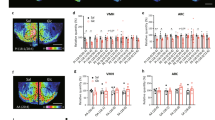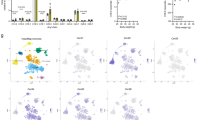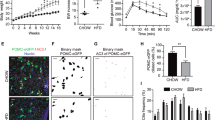Abstract
The enzyme carnitine palmitoyltransferase-1 (CPT1) regulates long-chain fatty acid (LCFA) entry into mitochondria, where the LCFAs undergo β-oxidation. To investigate the mechanism(s) by which central metabolism of lipids can modulate energy balance, we selectively reduced lipid oxidation in the hypothalamus. We decreased the activity of CPT1 by administering to rats a ribozyme-containing plasmid designed specifically to decrease the expression of this enzyme or by infusing pharmacological inhibitors of its activity into the third cerebral ventricle. Either genetic or biochemical inhibition of hypothalamic CPT1 activity was sufficient to substantially diminish food intake and endogenous glucose production. These results indicated that changes in the rate of lipid oxidation in selective hypothalamic neurons signaled nutrient availability to the hypothalamus, which in turn modulated the exogenous and endogenous inputs of nutrients into the circulation.
This is a preview of subscription content, access via your institution
Access options
Subscribe to this journal
Receive 12 print issues and online access
$209.00 per year
only $17.42 per issue
Buy this article
- Purchase on Springer Link
- Instant access to full article PDF
Prices may be subject to local taxes which are calculated during checkout




Similar content being viewed by others
References
Hill, J.O. & Peters, J.C. Environmental contributions to obesity epidemic. Science 280, 1371–1374 (1998).
Kopelman, P.G. & Hitman, G.A. Diabetes. Exploding type II. Lancet 352 (suppl. 4), SIV5 (1998).
Woods, S.C., Lotter, E.C., McKay, D.L. & Porte, D., Jr. Chronic intracerebroventricular infusion of insulin reduces food intake and body weight of baboons. Nature. 282, 503–505 (1979).
Bruning, J.C. et al. Role of brain insulin receptor in control of body weight and reproduction. Science 289, 2122–2125 (2000).
Friedman, J.M. Obesity in the new millennium. Nature 404, 632–634 (2000).
Air, E.L. et al. Small molecule insulin mimetics reduce food intake and body weight and prevent development of obesity. Nat. Med. 8, 179–183 (2002).
Schwartz, M.W., Woods, S.C., Porte, D. Jr., Seeley, R.J. & Baskin, D.G. Central nervous system control of food intake. Nature 404, 661–671 (2000).
Ahima, R.S. et al. Role of leptin in the neuroendocrine response to fasting. Nature 382, 250–252 (1996).
Wang, J., Liu, R., Hawkins, M., Barzilai, N. & Rossetti, L. A nutrient-sensing pathway regulates leptin gene expression in muscle and fat. Nature 393, 684–688 (1998).
Loftus, T.M. et al. Reduced food intake and body weight in mice treated with fatty acid synthase inhibitors. Science 288, 2379–2381 (2000).
Obici, S. et al. Central administration of oleic acid inhibits glucose production and food intake. Diabetes 51, 271–275 (2002).
Makimura, H. et al. Cerulenin mimics effects of leptin on metabolic rate, food intake, and body weight independent of the melanocortin system, but unlike leptin, cerulenin fails to block neuroendocrine effects of fasting. Diabetes 50, 733–739 (2001).
Shimokawa, T., Kumar, M.V. & Lane, M.D. Effect of a fatty acid synthase inhibitor on food intake and expression of hypothalamic neuropeptides. Proc. Natl. Acad. Sci. USA 99, 66–71 (2002).
McGarry, G.D., Mannaert, G.P. & Foster, D.W. A possible role for malonyl-CoA in the regulation of hepatic fatty acid oxidation and ketogenesis. J. Clin. Invest. 60, 265–270 (1977).
Zammit, V.A. Regulation of ketone body metabolism. A cellular perspective. Diabetes Rev. 2, 132–155 (1994).
Obici, S. et al. Central melanocortin receptors regulate insulin action. J. Clin. Invest. 108, 1079–1085 (2001).
Liu, L. et al. Intracerebroventricular (ICV) leptin regulates hepatic but not peripheral glucose fluxes. J. Biol. Chem. 273, 31160–31167 (1998).
Miller, J.C., Gnaedinger, J.M. & Rapaport, S.I. Utilization of plasma fatty acid in rat brain: distribution of [14C]palmitate between oxidative and synthetic pathways. J. Neurochem. 49, 1507–1514 (1987).
Goto M. & Spitzer J.J. Fatty acids profiles of various lipids in the cerebrospinal fluid. Proc. Exp. Biol. Med. 136, 1294–1296 (1971).
Briscoe, C.P. et al. The orphan G protein-coupled receptor GPR40 is activated by medium and long chain fatty acids. J. Biol. Chem. 278, 11303–11311 (2003).
Lunzer, M.A., Manning, J.A. & Ockner, R.K. Inhibition of rat liver acetyl coenzyme A carboxylase by long chain acyl coenzyme A and fatty acid. J. Biol. Chem. 252, 5483–5487 (1977).
Brun, T., Assimacopoulos-Jeannet, F., Corkey, B.E. & Prentki, M. Long-chain fatty acids inhibit acetyl-CoA carboxylase gene expression in the pancreatic beta-cell line INS-1. Diabetes 46, 393–400 (1997).
Blazquez, C., Sanchez, C., Daza, A., Galve-Roperh, I. & Guzman, M. The stimulation of ketogenesis by cannabinoids in cultured astrocytes defines carnitine palmitoyltransferase I as a new ceramide-activated enzyme. J. Neurochem. 72, 1759–1768 (1999).
Di Marzo, V. et al. Leptin-regulated endocannabinoids are involved in maintaining food intake. Nature 410, 822–825 (2001).
Esser, V., Britton, C.H., Weis, B.C., Foster, D.W. & McGarry, J.D. Cloning, sequencing, and expression of a cDNA encoding rat liver carnitine palmitoyltransferase I. Direct evidence that a single polypeptide is involved in inhibitor interaction and catalytic function. J. Biol. Chem. 268, 5817–5822 (1993).
Birikh, K.R., Heaton, P.A. & Eckstein, F. The structure, function and application of the hammerhead ribozyme. Eur. J. Biochem. 245, 1–16 (1997).
Boussif, O. et al. A versatile vector for gene and oligonucleotide transfer into cells in culture and in vivo: polyethylenimine. Proc. Natl. Acad. Sci. USA 92, 7297–7301 (1995).
Goula, D. et al. Size, diffusibility and transfection performance of linear PEI/DNA complexes in the mouse central nervous system. Gene Ther. 5, 712–717 (1998).
Palkovits M. Isolated removal of hypothalamic or other brain nuclei of the rat. Brain Res. 59, 449–450 (1973).
Obici, S., Feng, Z., Karkanias, G., Baskin, D.G. & Rossetti, L. Decreasing hypothalamic insulin receptors causes hyperphagia and insulin resistance in rats. Nat. Neurosci. 5, 566–572 (2002).
Paxinos, G. & Watson, C. The Rat Brain in Stereotaxic Coordinates 3rd edn. (Academic Press, 1997).
Arduini, A. et al. Evidence for the involvement of carnitine-dependent long-chain acyltransferases in neuronal triglyceride and phospholipid fatty acid turnover. J. Neurochem. 62, 1530–1538 (1994).
Woldegiorgis, G., Spennetta, T., Corkey, B.E., Williamson, J.R. & Shrago, E. Extraction of tissue long-chain acyl-CoA esters and measurement by reverse-phase high-performance liquid chromatography. Anal. Biochem. 150, 8–12 (1985).
Acknowledgements
This work was supported by grants from the National Institutes of Health (to L.R.; DK48321 and DK45024) and from the Albert Einstein College of Medicine Diabetes Research & Training Center. S.O. was the recipient of a post-doctoral fellowship and a Junior Faculty Award from the American Diabetes Association.
Author information
Authors and Affiliations
Corresponding author
Ethics declarations
Competing interests
A.A. and R.C. are employed by a drug company and they may have interest in the development of ST1326 as a potential treatment for diabetes or obesity.
Rights and permissions
About this article
Cite this article
Obici, S., Feng, Z., Arduini, A. et al. Inhibition of hypothalamic carnitine palmitoyltransferase-1 decreases food intake and glucose production. Nat Med 9, 756–761 (2003). https://doi.org/10.1038/nm873
Received:
Accepted:
Published:
Issue Date:
DOI: https://doi.org/10.1038/nm873
This article is cited by
-
CPT1A in AgRP neurons is required for sex-dependent regulation of feeding and thirst
Biology of Sex Differences (2023)
-
GPR40/FFA1 Free Fatty Acid Receptors and Their Functional Role
Neuroscience and Behavioral Physiology (2021)
-
Ketogenic diet aggravates cardiac remodeling in adult spontaneously hypertensive rats
Nutrition & Metabolism (2020)
-
Activation of GPR40 induces hypothalamic neurogenesis through p38- and BDNF-dependent mechanisms
Scientific Reports (2020)
-
Neuronal control of peripheral nutrient partitioning
Diabetologia (2020)



